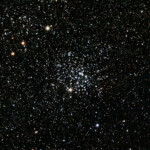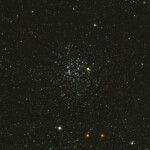Messier 52, also known as NGC 7654, is an open cluster of stars in the highly northern constellation of Cassiopeia. It can be seen from Earth under a good night sky with binoculars. The brightness of the cluster is influenced by extinction, which is stronger in the southern half.

M52 (NGC 7654)
Messier 52, also known as NGC 7654, is an open cluster of stars in the northern constellation of Cassiopeia. It can be seen from Earth under a good night sky with binoculars. The brightness of the cluster is influenced by extinction, which is stronger in the southern half.
Photographed with MN190 reflector telescope and Atik 360EX CCD camera in Stuvsta, March 2022. Exposure was 15*2 min RGB each and 30 * 1 min Lum.
